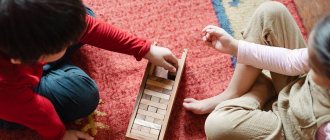Patterns of speech development of a young child
Definition 1
Speech development is the process of gradual mastery of linguistic means and the skills of their use in the system of communicative interaction.
Speech development is a gradual process. Speech begins its formation from an early age and actively develops in the preschool age period. The child begins to pronounce his first words at the age of one. Gradually, the vocabulary expands and becomes more complex, and by the end of early childhood the child speaks about 1,500 words. Naturally, this development dynamics is normal and optimal. Different children may experience deviations from these indicators, both for the better and for the worse.
Are you an expert in this subject area? We invite you to become the author of the Directory Working Conditions
It should be noted that the speech development of young children has a number of patterns. They are:
- The need to influence speech processes to activate them. In other words, it is necessary to develop the child’s skill in using his speech apparatus.
- Lack of content of speech activity. To begin speech activity, the child needs the accumulation of speech content, i.e. formation of vocabulary and the basics of its use.
- Ignorance of verbal forms of speech in the early stages of development. These forms must be shown to the child and mastered by him.
- The connection between the speech apparatus and thinking. Speech development is based on mental operations.
- Language development in the context of child social interaction. And this requires establishing the child’s social contacts, i.e. his immersion in society.
These patterns determine the need for special events and activities with a young child, focused on his speech development. And, first of all, it is necessary to introduce the child to the social environment and form the foundations of interaction with it. It is carried out in the conditions of a preschool educational organization, which creates special conditions for the general development of the child and the formation of his speech activity.
Finished works on a similar topic
Course work Development of speech of young children in preschool educational institutions 470 ₽ Abstract Development of speech of young children in preschool educational institutions 260 ₽ Test work Development of speech of young children in preschool educational institutions 200 ₽
Receive completed work or specialist advice on your educational project Find out the cost
CHILDHOOD GUIDE
From work experience
“Organization of the speech environment for young children in preschool educational institutions”
Chuzhekova Marina Nikolaevna,
teacher of MBDOU No. 7,
village Nickel Murmansk region.
The leading place in the preschool education system is given to the implementation of speech tasks. Modern research in this area indicates that most children do not have coherent speech skills by the end of preschool age. Their vocabulary is not rich.
In organizing my work, I strive to ensure that every meeting with children has the character of an educational and playful activity and is emotionally charged. I believe that my work on speech development will be more effective if during the training I use techniques that promote the development of motivation, both traditional and innovative.
The goal of my work in this direction is to satisfy and further develop the needs of young children for attention, cooperation, communication, and speech development.
Main goals:
- To promote the formation and further development of personal, business and situational business communication between a child and an adult.
- Create favorable conditions for children to communicate with each other.
- To introduce students to the richness of the literary heritage of the people, highly artistic and accessible literary works, and to develop interest in them.
- Develop artistic perception, the ability to listen to literary text; watch puppet shows, show emotional responsiveness to what is perceived, empathize with the characters of a work of art;
- Enrich the child’s passive speech, form the baby’s own active speech; stimulate and maintain interest in oriented activities in a language environment.
- Stimulate the desire to perform game actions that correspond to the content of their familiar works.
- To promote the accumulation and development of gaming experience, the manifestation of independence when playing nursery rhymes, jokes, and fairy tales.
- Cultivate interest in the book, teach the ability to use it, look at the illustrations (in books intended for children).
- Encourage children to reproduce short poems, individual words, expressions from perceived artistic literary works.
Creating conditions for the speech development of young children
A child’s speech activity depends on how the play, subject-development environment of his life is structured, what toys, illustrative material, equipment and aids it consists of, what their developmental potential is, how they are located, and whether they are available for independent activity.
It is desirable that all the furniture in the group room be uniform in style, simple in shape and have a modern silhouette. Equipment in the group should be placed so that it is convenient for the teacher to approach each child during games and activities. When placing furniture, you should try to free up as much floor space as possible for children’s games and active activities.
Young children learn about the world by exploring it through their senses. Therefore, a space is created for children for speech, play and sensory development, which includes :
— Game guide “Magic Mat” for the development of motor, sensory, speech and thinking abilities of children. Functions of this manual: developmental, diagnostic, communicative, game therapy, entertaining.
— Various types of educational games : lotto, dominoes, mosaic, folding cubes with cut pictures.
— Sets of pictures for grouping 3-4 in each group (realistic images): animals, animals with babies, birds, vegetables, fruits, clothes, dishes, furniture, transport, household items, toys.
— Sets of paired pictures (subject) for comparison, of the same topic.
— Sets of paired pictures of the “lotto” type (of 2-3 parts), of the same theme.
— Cut-out (folding) cubes with subject pictures, divided into 2-4 parts.
— Cut pictures , divided into 2 parts in a straight line.
— A series of 2-3 pictures to establish the sequence of actions and events (fairy-tale, everyday, game situations)
— Thematic pictures (with various themes close to the child - fairy tales, social everyday life), large format.
— Sounding toys , contrasting in timbre and nature of sound production (bells, drums, rubber squeakers, rattles).
— A dressing room with a mirror is a necessary attribute of children’s speech development. The children look in the mirror and, with the help of an adult, dress up in scarves, capes, and skirts that their mothers lovingly sewed for the children. The dressing up corner is replenished by introducing new attributes: beads, hats, ribbons, bows, etc.
— The book area in the group room is especially popular with children and contributes to the development of children’s speech. Young children take “reading” books very seriously. It should contain 3-4 copies of thick-bound books with the same content; toys for playing with them can be connected to them based on the content of the plot, for example: we read about a bear, we put a bear toy with the books, etc. The intimacy and warmth of the setting is created by the lamp. With the sun on, kids really enjoy looking at illustrations, listening to their favorite fairy tales, and turning through the pages of a photo album with photographs of family members.
— The theater area includes: toy theatre, tabletop theatre, flat theatre, bibabo, flannelgraph theatre, finger theatre, theater “on skittles”, “on sticks”, “on a glove”, theater of “wind-up toys”.
Organization of the educational process on speech development
Interest in the environment in early childhood is involuntary and largely socially determined. It is impossible to force a baby to watch or listen, but you can interest him in many ways if you consider the following points:
— Offers for the child to go play, sleep, eat, study, etc. must coincide with his needs. This is possible when the daily routine is strictly followed and the baby’s behavior is monitored in order to determine his condition.
— It is important for the teacher to create conditions that exclude the child’s unpleasant sensations. Conditional connections in young children are formed easily and quickly. If one day the baby was upset about something, then in the future he will have a negative attitude towards it.
— Regular processes should begin when the child’s nervous system is in a calm state; nothing should be done when the baby is crying or excited.
— Carry out an individual approach to children, taking into account the behavioral characteristics and level of speech development of each child.
- An adult must accompany all actions with words. This prepares the baby for the upcoming action, arouses interest in it, and develops speech.
— The teacher strives to expand the children’s vocabulary and help them learn new speech structures, for which it is necessary to read and look at books with illustrations with them; strive to encourage repeating what has been read or told.
- Give the child time to finish what he wants to say. The teacher should not interrupt the child by correcting pronunciation and word order. After all, the baby will eventually be able to perceive correct speech by ear. You need to look at the baby when he is talking, show that you are listening to him attentively and that his words are not indifferent to you.
— Adults should pay attention not only to their words, but also to the sound of their voice, facial expressions, gestures, and posture. The teacher's face should be friendly and smiling while communicating with the child.
— You need to correct a child’s speech errors tactfully and indirectly on behalf of a toy, or any literary character. It is advisable to create a situation so that the mistake seems easy to correct, and the activity you would like to engage your child in seems accessible and doable.
— When organizing the educational process with children, it is necessary to follow the requirements of didactics. Provide time for speech development games and activities.
It has been established that the best time for activities with a child is the first part of wakefulness, when the baby is in a state of optimal excitability and not immediately after eating, but 30 minutes later. It is not recommended to conduct activities with children at an unfavorable time for this: immediately after sleep, when the child is still in a somewhat inhibited state, immediately after a walk, when the child is already somewhat tired, or immediately before meals and before bed, which reduces the quality of the next process.
Games and activities for children are carried out in small subgroups (7-8 people) or individually.
The educator is obliged to accurately determine the program content, which includes educational, health-improving and developmental tasks. Think about what material to give to children, how to present it more effectively. Provide options and ways to accommodate children so that they are comfortable: everything is visible and audible, and each child takes an active part to the best of their strength and capabilities.
Games and activities are conducted with children in an entertaining, interesting way. Visual didactic material should be dynamic, bright, and sounding. In order for children to perceive information qualitatively and firmly master speech skills, it is necessary to adhere to the following intervals when repeating classes:
- after the first lesson, you should return to it in 2-3 days; but with changes in program objectives and content;
- after the second lesson, contact him in 5-7 days;
- after the third lesson, make an interval of 7-10 days and conduct it in a more complicated version.
Complications of games-activities may include the following:
— in the gradual presentation of new information;
- changing gaming and didactic material;
— in the use of new methodological techniques;
- for example, telling a fairy tale using a tabletop theater, illustrations or paintings, or without the use of visuals.
In the second year of life, the child’s ability to imitate and reproduce what is heard sharply increases, and active speech improves. The child's needs and desires are expressed in words. All aspects of speech are improved.
Children love to listen and quickly remember poems, songs, nursery rhymes, and jokes. This is a significant indicator of the development of their thinking, memory and, of course, figurative, emotional speech. A child can not only listen, but also understand literary works and adult stories. Children should read fairy tales, nursery rhymes, and poems as often as possible. Everything that the baby perceives, he, on his own initiative, begins to reflect in speech. Descriptive speech, speech-monologue appears.
You can talk to the child about his past impressions and what he will do, where he will go, etc., that is, the planning function of speech begins to form. This function, first of all, appears precisely in practical activities (drawing, designing), and it is very important for general mental development.
Practical activities are of great importance for the development of speech.
In every joint activity, try to provide for situations that, unnoticed by the baby, involve him in verbal communication. When organizing any activity for a child, you should help him make verbal contact with his peers. “Speech yard” as a form of speech development subject-spatial environment Organization of an area for construction and constructive games in an early age group Games and exercises for the development of speech in young children Organization of interaction with families of pupils based on partnerships >
Passport of the speech development center in the second junior group “Solnyshko”
Speech Development Center Passport
in the second junior group "Sun"
Speech
– the most complex mental process, subject only to man! The issue of speech development in modern children is relevant, because every year the number of children with speech disorders increases.
Our group has created a corner for speech development “Rechevichok”
, according to the age and interest of the children.
The main character of the corner
is
“ Game character - Andrei doll ”.
The speech corner is based on gaming and didactic material aimed at developing:
1) Articulatory
motor skills
(object pictures-supports; articulatory gymnastics in verses and pictures, mirrors for a subgroup of children)
2)Correct breathing
– the key to success in mastering difficult to pronounce sounds. Using breathing exercises, you can prevent nervous overstrain, restore proper speech breathing, create a positive emotional mood, and also overcome the child’s speech disorders.
In this corner, to develop proper breathing, we have created didactic games: “Air football”, “Fishing”, “Feed the animals”, as well as turntables, cups, a simulator for developing the strength of the air stream, whistles, plumes, “Bottle with a blizzard” .
3)For the development of coherent speech,
we use sets of subject and subject pictures (based on the lexical topics of the week): “Animals of our forests”, “Pets and their babies”, “Furniture”, “Transport”, “Birds”, “Insects”, “Vegetables”, “Fruits” ", "Berries", "Mushrooms", "Professions", "Seasons", "Stories in Pictures" (part 1 and 2); didactic games and manuals: “Where is whose shadow”, “Seasons”, “Who lives where?”, “Who eats what”, “Whose tail?”, “Gather the harvest”, “Part and whole”, card index of didactic games on speech development; as well as baby books and works of art according to the program, cut-out pictures and different types of theater.
4) Benefits for developing fine motor skills:
finger games based on fairy tales, lacing tale “Kolobok”, lacing “Insects”, “Hedgehog”, insert games, su-jok, walnuts, cones, stencils, clothespins (“Sun”, “Hedgehog”), small toys (kinders)
5) Material on onomatopoeia:
“Noise instruments”, children’s musical instruments: drums, pipe, tambourine, rattle, rattles, musical and didactic game “Musical professions”.
6) Games and tutorials for automating sounds:
album on automation of sounds, pure sayings, poems and nursery rhymes, subject and plot pictures, different types of theater: finger, table, cone table theater, “Bi-Ba-Bo”-mitten doll, glass table theater, flannelgraph, multifunctional screen for theatricalization , theater masks; small toys.
7) Games for vocabulary and grammar:
subject pictures on lexical topics.
The content of the speech corner is determined in accordance with the program and age of the children.
In the speech corner we use objects from the theater and music corner, since dramatization promotes the development of coherent speech.
Thank you for your attention!





